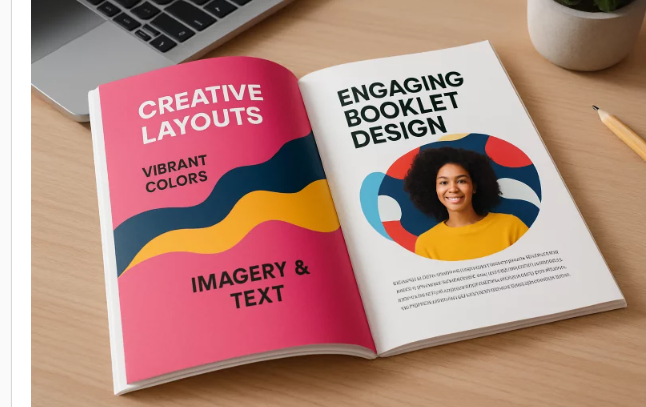Key Takeaways
- Understand your audience thoroughly to tailor every design decision.
- Develop a cohesive and memorable theme for visual and stylistic unity.
- Utilize color and typography to create hierarchy, mood, and clarity.
- Incorporate purposeful, high-quality visuals to support your message.
- Experiment with layouts for a unique, engaging reading experience.
- Blend digital and print by using interactive elements for deeper engagement.
- Draw inspiration from external design resources to stay on top of industry trends whenever possible.
Table of Contents
- Understanding Your Audience
- Developing a Unique Theme
- Leveraging Color and Typography
- Incorporating High-Quality Visuals
- Exploring Innovative Layouts
- Integrating Interactive Elements
Booklets remain among the most versatile and effective forms of print media for conveying information, elevating brands, and telling compelling stories. A well-designed booklet is not simply a collection of pages bound together—it is a unified creative expression that strikes a balance between aesthetics and functionality. Whether your goal is to inform, persuade, or entertain, crafting a booklet that genuinely engages readers requires creative thinking, a thorough understanding of design principles, and an unwavering focus on the needs of your intended audience. And for those seeking a professional, polished finish, you can always order booklets with Printivity and trust that your vision will be realized with high-quality printing and expert craftsmanship. Booklets serve a diverse range of purposes, from marketing brochures and event programs to product guides and educational resources. Thoughtful design helps these small publications achieve more than the sum of their parts: when informative content pairs with eye-catching visuals and interactive features, booklets become memorable keepsakes that readers revisit and share. To create booklets that truly stand out, it’s vital to approach their design holistically, from conceptual planning to the final print. Below, we’ll dive into effective strategies that will elevate your next booklet project and ensure lasting impact.
Understanding Your Audience
The first step in creating an engaging booklet is understanding exactly who your audience is and what makes them tick. Every design choice—from imagery and language to layout and interactivity—should be informed by the preferences, habits, and challenges of your target readers. Ask yourself: Are you speaking to energetic students, busy professionals, families, or a niche community of enthusiasts? Pinpointing your audience allows you to craft messaging that resonates and design aesthetics that appeal directly to your readers’ tastes. To gain deeper insight, develop reader personas that encapsulate common goals, pain points, and motivations. Conduct surveys, interviews, or brief polls to collect real feedback about what your audience needs or expects from your booklet. For instance, when designing a booklet for children’s summer camps, it’s crucial to use lively illustrations, bold colors, and minimal text to spark joy and curiosity. In contrast, a financial planning guide for executives might require sleek layouts, neutral color schemes, and concise language to inspire trust and project professionalism. The key is to adapt your design language, content complexity, and visuals to your readership for maximum engagement and effectiveness.
Developing a Unique Theme
A distinctive and well-executed theme is what sets memorable booklets apart from forgettable ones. Themes can take the shape of a visual motif, a narrative thread, or even a specific mood woven consistently throughout the publication. By establishing a clear thematic identity, you guide your reader through the content with a sense of cohesion and purpose. A unified theme also reinforces your brand’s image, making the booklet instantly recognizable and leaving a lasting impression.
Practical Ways to Build a Theme
- Color Palette: Select a palette of two to four complementary colors that evoke the emotions you wish to convey, whether energetic and playful or calm and authoritative. Use these colors as a thread throughout your booklet to create unity and visual flow.
- Typography: Curate font pairings that define your booklet’s personality. For example, pair a bold, modern title font with a clean, easy-to-read body font for marketing material, or choose whimsical, hand-drawn fonts for a community event program.
- Motif or Iconography: Include repeating graphic elements—such as shapes, icons, or patterns—that reflect your central message or branding elements and tie together different sections of your booklet.
Perfecting your booklet’s theme often means experimenting with several options and seeking unbiased feedback. Share early drafts with colleagues or trusted readers, gather impressions, and be ready to refine your theme until it achieves clarity and resonance throughout the booklet.
Leveraging Color and Typography
Color and typography are more than decorative—they are powerful tools that can direct attention, set tone, and make information instantly digestible. The emotional and psychological effects of color are well documented: cool tones like blues and greens can foster calm and trust. At the same time, warmer hues such as reds and oranges inject energy and urgency. Use your color scheme to highlight critical information, establish visual hierarchy, and gently guide readers’ eyes from one section to the next.
Tips for Effective Use
- Hierarchy: Establish a clear system of headings, subheadings, and body text through careful manipulation of type size, weight, and style. This helps readers quickly scan for important points and navigate the content effortlessly.
- Contrast & Readability: Maintain high contrast between your text and background colors for maximum ease of reading. This is especially important for lengthy passages or essential information.
- Balance: Limit your font and color selections to a few deliberate choices, preserving harmony and cohesiveness. Inconsistent or overwhelming design elements can distract or fatigue your audience.
Effective color and typography choices enhance your booklet’s visual appeal and communicative power, making it inviting and easy to read.
Incorporating High-Quality Visuals
Impeccable visuals are a hallmark of professional booklet design. Whether through custom illustrations, high-resolution photographs, or detailed infographics, visuals can bring stories to life, simplify complicated ideas, and stir emotions in ways text alone cannot. They also serve as visual anchors, breaking up dense passages and giving readers natural points to pause, reflect, and absorb information.
Best Practices for Visuals
- Use only original photography or reputable stock resources to maintain crisp, professional image quality.
- Place images thoughtfully to create rhythm, balance, and interest—spread them across pages to pace your readers and avoid lengthy blocks of text.
- Leverage infographics and diagrams to make numerical data or complex subjects more accessible, ensuring content is understood at a glance.
- Keep a consistent visual style throughout the booklet, aligning all visuals with your established theme and brand guidelines.
Remember that visuals should enhance, not distract. Carefully curate images that reinforce your key points, always prioritizing clarity and purposeful design.
Exploring Innovative Layouts
In today’s visually saturated world, experimentation with fresh formats and layouts is essential to draw and keep your audience’s attention. Think beyond the traditional page-by-page structure—try out creative layouts that optimize space and offer interactive discovery. Unique folds, die-cuts, and non-standard booklet sizes can introduce unexpected moments of delight and strengthen your message.
Layout Ideas to Try
- Accordion Folds: These interactive folds allow readers to unfold stories or guides gradually, creating a sense of progression and curiosity.
- Grid-Based Layouts: Modular grids enable you to artfully juxtapose images, pull quotes, and graphical callouts, bringing both structure and dynamism to your page design.
- Whitespace: Don’t shy away from leaving some areas blank; generous use of whitespace increases readability, offers visual relief, and gives your content room to breathe.
A well-considered layout tailors the reader’s journey, sustaining interest and comprehension from the cover to the final page.
Integrating Interactive Elements
Booklet design now extends beyond ink-on-paper, inviting readers to engage with both physical and digital experiences. Incorporating interactive elements such as QR codes allows you to link readers to supplemental media—videos, online forms, or extended articles—making your booklet a leap-off point to richer content and deeper engagement. For those wanting to push the boundaries, augmented reality (AR) experiences can transform static pages into dynamic portals. Imagine your audience scanning a page with their smartphone and instantly viewing explainer animations, hearing testimonials, or interacting with product demos—this level of immersion creates lasting memories. To ensure these advanced features work flawlessly in print, it’s wise to collaborate with skilled digital designers or consult print professionals.



